
Accordions are a family of box-shaped musical instruments of the bellows-driven free reed aerophone type. The essential characteristic of the accordion is to combine in one instrument a melody section, also called the diskant, usually on the right-hand keyboard, with an accompaniment or Basso continuo functionality on the left-hand. The musician normally plays the melody on buttons or keys on the right-hand side, and the accompaniment on bass or pre-set chord buttons on the left-hand side. A person who plays the accordion is called an accordionist.
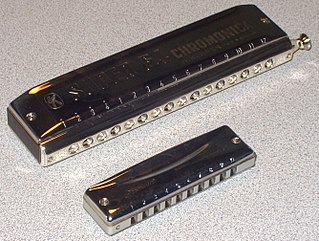
The harmonica, also known as a French harp or mouth organ, is a free reed wind instrument used worldwide in many musical genres, notably in blues, American folk music, classical music, jazz, country, and rock. The many types of harmonica include diatonic, chromatic, tremolo, octave, orchestral, and bass versions. A harmonica is played by using the mouth to direct air into or out of one holes along a mouthpiece. Behind each hole is a chamber containing at least one reed. The most common is the diatonic Richter-tuned with ten air passages and twenty reeds, often called the blues harp. A harmonica reed is a flat, elongated spring typically made of brass, stainless steel, or bronze, which is secured at one end over a slot that serves as an airway. When the free end is made to vibrate by the player's air, it alternately blocks and unblocks the airway to produce sound.

A concertina is a free-reed musical instrument, like the various accordions and the harmonica. It consists of expanding and contracting bellows, with buttons usually on both ends, unlike accordion buttons, which are on the front.

The bandoneon is a type of concertina particularly popular in Argentina and Uruguay. It is a typical instrument in most tango ensembles. As with other members of the concertina family, it is held between the hands, and played by pulling and pushing air through bellows, routing it through sets of tuned metal reeds by pressing the instrument's buttons. Unlike most accordions, bandoneons always employ the same sets of reeds to produce their sound, and do not usually have the register switches common on accordions. Nevertheless, the bandoneon can be played very expressively, using various bellows pressures and other techniques.

The English concertina is a member of the concertina family of free-reed musical instruments. Invented in England in 1829, it was the first instrument of what would become the concertina family.

A Chemnitzer concertina is a musical instrument of the hand-held bellows-driven free-reed category, sometimes called squeezeboxes. The Chemnitzer concertina is most closely related to the bandoneón, more distantly to the other concertinas, and accordions.

The term squeezebox is a colloquial expression referring to any musical instrument of the general class of hand-held bellows-driven free reed aerophones such as the accordion and the concertina. The term is so applied because such instruments are generally in the shape of a rectangular prism or box, and the bellows is operated by squeezing in and drawing out.

The garmon, commonly called garmoshka, is a kind of Russian button accordion, a free-reed wind instrument. A garmon has two rows of buttons on the right side, which play the notes of a diatonic scale, and at least two rows of buttons on the left side, which play the primary chords in the key of the instrument as well as its relative harmonic minor key. Many instruments have additional right-hand buttons with useful accidental notes, additional left-hand chords for playing in related keys, and a row of free-bass buttons, to facilitate playing of bass melodies. The term "Garmon" means overcomer, winner or "noble" believed epistemologically to derive from the term for "blue" which nobility wore. It is believed perhaps Russian aristocratic, tzars and or royal leadership had garmons played in their courts.

The trikititrikitixa, or eskusoinu txiki ) is a two-row Basque diatonic button accordion with right-hand rows keyed a fifth apart and twelve unisonoric bass buttons. The onomatopoeia trikitixa, apparently stemming from the sound emitted by the tambourine, originally referred to a traditional Basque ensemble, made up of the instrument which now bears the name as well as alboka, txistu and other instruments.

The Flutina is an early precursor to the diatonic button accordion, having one or two rows of treble buttons, which are configured to have the tonic of the scale, on the "draw" of the bellows. There is usually no bass keyboard: the left hand operates an air valve. A rocker switch, called a "bascule d'harmonie" is in the front of the keyboard. When this switch is thumb activated, it would open up a pallet (a pad that covers a tone hole, at the other end of the key button, for a simple Tonic/Dominant drone: Tonic on the draw and Dominant on the press, e.g. Tonic notes C/g, and Dominant G/d, without any major or minor thirds.
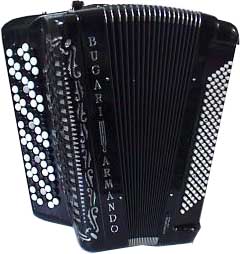
A chromatic button accordion is a type of button accordion where the melody-side keyboard consists of rows of buttons arranged chromatically. The bass-side keyboard is usually the Stradella system or one of the various free-bass systems. Included among chromatic button accordions are the Russian bayan and Schrammel accordion. There can be 3 to 5 rows of vertical treble buttons. In a 5 row chromatic, two additional rows repeat the first 2 rows to facilitate options in fingering.

A melodeon or diatonic button accordion is a member of the free-reed aerophone family of musical instruments. It is a type of button accordion on which the melody-side keyboard contains one or more rows of buttons, with each row producing the notes of a single diatonic scale. The buttons on the bass-side keyboard are most commonly arranged in pairs, with one button of a pair sounding the fundamental of a chord and the other the corresponding major triad.
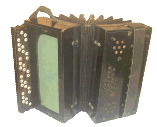
A Schrammel accordion is an accordion with a melody keyboard in the chromatic B-Griff system and a twelve-button diatonic bass keyboard. It is named for a traditional combination of two violins, accordion or clarinet, and contraguitar known as a Schrammelquartet – a group that played Schrammelmusik in the Vienna chamber music tradition.

A tremolo harmonica is a type of diatonic harmonica, distinct by having two reeds per note. In a tremolo harmonica, the two reeds are tuned slightly off a reference pitch, one slightly sharp and the other slightly flat. This gives a unique wavering or warbling sound created by the two reeds being not exactly in tune with each other and difference in their subsequent waveforms acting against one another. The degree of beating can be varied depending on the desired effect. Instruments where the beating is faster due to the reeds being farther apart from the reference pitch are called "wet", whereas those where the beating is slower and less noticeable due to the reeds being more closely in tune are called "dry".
The Saratovskaya garmonika, named after the Russian city of Saratov, is a colorful variant on the standard one row push–pull diatonic button accordion. The chief distinguishing characteristic of this little folk accordion is that it plays the tonic scale on the bellows draw and the dominant on the bellows press, the reverse of a standard diatonic box. Another curious feature is the addition of two bells on the top of the instrument which are struck with tiny metal hammers attached to the bass and chord buttons for rhythmic accompaniment. They add a fun accent on dance tunes. It is possible to play the basses very lightly and avoid activating the bells, as they become rather tiresome after a while. The basses also have an additional tonic chord button in the center, lighter in tone than the regular chord, which is not attached to the hammers.
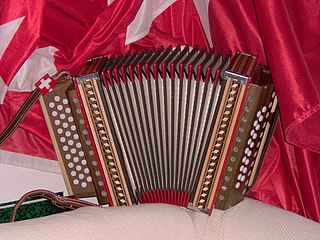
The Schwyzerörgeli is a type of diatonic button accordion used in Swiss folk music. The name derives from the town/canton of Schwyz where it was developed. Örgeli is the diminutive form of the word Orgel (organ). Outside of Switzerland the instrument is not well known and is hard to find.
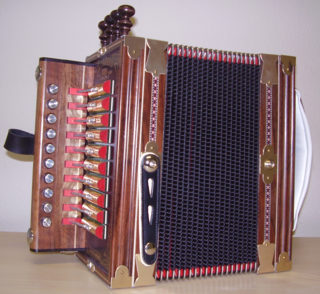
A Cajun accordion, also known as a squeezebox, is single-row diatonic button accordion used for playing Cajun music.

The Steirische Harmonika is a type of bisonoric diatonic button accordion important to the alpine folk music of Croatia, Slovenia, the Czech Republic, Austria, the German state of Bavaria, and the Italian South Tyrol. The Steirische Harmonika is distinguished from other diatonic button accordions by its typically richer bass notes, and by the presence of one key per scale row that has the same tone on both compression and expansion of the bellows, called a Gleichton. The bass notes earn the distinction Helikonbässe because they use bigger reeds with duralumin reed frames and a special chamber construction that amplifies its bass tones to give it a loud sound reminiscent of a Helicon tuba.

Khromka is a type of Russian garmon. It is the most widespread variant in Russia and in the former USSR. Nearly all Russian garmons made since the mid of the 20th century are khromkas.

The Anglo or Anglo-German concertina is a member of the concertina family of free-reed instruments.






















